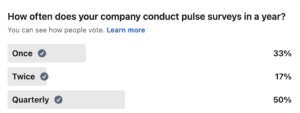As companies continue to embrace the hybrid + remote workplace model – distributed teams grow, it’s getting harder to gauge employee engagement levels.
Gathering and acting on employee feedback frequently has become more important for your distributed teams, if you want to improve engagement and retention. According to Gallup, a leader in workplace consulting, when employees feel engaged, they care about the company and do their best to achieve its goals.
Organizations have relied on annual or semi-annual employee engagement surveys to get insights into pain points, concerns, and employee needs. While these surveys offer information about sentiments, they often fall short of providing real-time feedback because of the lengthy intervals. Pulse surveys bridge the gap between larger surveys in the form of frequent, concise stills of employee engagement.
What are pulse surveys?
Pulse surveys are snapshots of employee feedback— quick, relevant, and essential for keeping your fingers on the pulse of your team’s satisfaction level. Unlike annual engagement or happiness surveys that require more resources and time, pulse surveys give you bite-sized insights into employee sentiments. They provide real-time views of employee engagement without disrupting the workflow of your employees with lengthy surveys.
HR leaders can easily integrate these surveys into business hours using automation and seamlessly provide data for line managers and leaders to fine-tune their team’s engagement strategies. Gallup reports that only 34% of employees are engaged in the workplace. Early results from our recent poll on LinkedIn showed for a small sample of respondents, the cadence of pulse surveys, if at all, at different companies varies between once, twice, and quarterly. It also showed that some people do not know what a pulse survey is, which makes this post more educational than informative.

Why you should be doing pulse surveys
A pulse approach drives engagement in remote teams.
In a remote (or hybrid) team, engaging with your employees is usually a huge task due to limited face time. Adding a pulse survey approach to your internal engagement strategy helps you give and receive feedback frequently. Being in constant communication about the things that matter to the people you work with provides them with a sense of belonging and, according to Gallup, they become involved in, enthusiastic about, and committed to their work in your company. A survey by Gallup found that companies lose between $450 billion to $550 billion annually in lost productivity from disengaged employees. You’ll be saving your company money and time by increasing the frequency of your feedback collection.
Show employees their feedback is valued.
In the previous point, we spoke about pulse surveys providing your employees with a sense of belonging. DNA of Engagement reports that encouraging and supporting programs fostering engagement and inclusion promote synergy and employee belonging. Pulse surveys serve as a tangible demonstration of your commitment to listening and showing that their feedback is valued. When employees see that their feedback is actively sought and acted upon, they trust you and collaborate genuinely each time.
Employees are more honest in surveys than with their managers.
Surveys generally offer employees a safe and confidential platform to express their thoughts and concerns without fear of repercussions or judgment from their managers. This anonymity allows them to provide candid feedback on their work environment, including managerial practices, company policies, and organizational culture.
Getting started with pulse surveys
Select relevant questions.
Be intentional about the questions you ask in pulse surveys. Focus on areas relevant to your organization’s current goals and challenges. Avoid overwhelming employees with too many questions, pulse surveys typically consist of 1-to-5 questions. Unlike lengthy annual surveys that may take up to 60 minutes to complete, they should take your employees no more than 60 seconds or you will get low participation.
Understand the importance of acting on feedback.
Again, a listening culture is important for inclusivity and productivity. HR leaders need to act on the feedback received from pulse surveys promptly. Failing to address the concerns brought up by your team or implement suggested improvements may lead to decreased employee participation and skepticism. For this, you can collaborate with managers and leadership to amplify the key message, implement changes, and encourage participation.
Automate pulse surveys and share reports
With automation, you can set up surveys quickly and efficiently. You are largely in control of the accuracy of the data collection process, devoid of bias. Once surveys are completed, as an HR leader, you will need to build a strong communication plan to convey the results to stakeholders and show the work in progress to employees.
Tips for effective pulse surveys
1. Anonymity
Keeping surveys anonymous means that you get honest thoughts from employees. When people feel safe, they’re honest and more likely to speak up about what’s going on. This will help you get the true picture of how employees feel, what they need, and what they think could be better with your strategy. Anonymity ensures everyone’s voice is heard (everyone who cares enough to speak), no matter their position! It’s like an open-door policy for remote teams.
2. Frequent tracking
Unlike traditional engagement surveys, pulse surveys can be done as often as needed—monthly, bi-weekly, or even weekly. HR can frequently track, adjust, and monitor the impact of their engagement initiatives over time.
3. Value employee feedback
Research by Deloitte suggests that employees prioritize organizational culture over compensation and benefits. Embracing a listening-based culture and implementing the changes from pulse survey feedback makes your employees feel seen and heard. This in turn leads to higher engagement levels and consequently, increased revenue.
How Vitay helps Recruiters and HR leaders with employee engagement.
Vitay helps HR leaders and recruiters verify and validate talents faster. Our employee engagement tool is an automated feedback software that allows you to:
- Get direct feedback about your recruiting processes.
- Conduct pulse surveys on newly hired employees integrating into your company culture.
- Measure new hire performance.
- Improve company engagement levels, productivity, and retention.
- Create survey question sets that best align with your company’s goals and automate them.
In addition, you can use Vitay’s software for employment pre-screening, background, and reference checks for new candidates before they are integrated into your company.
To learn more about using Vitay’s employee feedback tool for pulse surveys, click here to speak with a product expert.






Comments are closed.